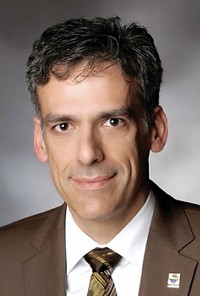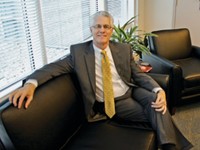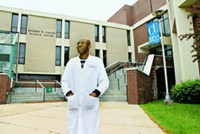Advertisement
Grab your lab coat. Let's get started
Welcome!
Welcome!
Create an account below to get 6 C&EN articles per month, receive newsletters and more - all free.
It seems this is your first time logging in online. Please enter the following information to continue.
As an ACS member you automatically get access to this site. All we need is few more details to create your reading experience.
Not you? Sign in with a different account.
Not you? Sign in with a different account.
ERROR 1
ERROR 1
ERROR 2
ERROR 2
ERROR 2
ERROR 2
ERROR 2
Password and Confirm password must match.
If you have an ACS member number, please enter it here so we can link this account to your membership. (optional)
ERROR 2
ACS values your privacy. By submitting your information, you are gaining access to C&EN and subscribing to our weekly newsletter. We use the information you provide to make your reading experience better, and we will never sell your data to third party members.
People
Research Corporation Turns 100
Foundation celebrates a century of advancing science
by Britt E. Erickson
April 9, 2012
| A version of this story appeared in
Volume 90, Issue 15

Although many people are unaware of the Research Corporation for Science Advancement, the small, philanthropic foundation based in Tucson has made a huge impact on chemistry and physics over the past 100 years.
Founded in 1912 by Frederick G. Cottrell, the organization was simply called Research Corporation until 2008. Known today for supporting early-career scientists and funding high-risk, interdisciplinary research, the foundation was initially set up to acquire inventions and license patents to industry. All profits were used to support future scientific research.
Cottrell described Research Corporation as “an experiment in the economics of technology transfer,” says John P. Schaefer, who served as president of the foundation from 1982 to 2005. For many decades, Research Corporation looked at promising inventions and worked on getting them into the hands of the public, Schaefer notes.
The first of those inventions was Cottrell’s electrostatic precipitator, a pollution-control device for smokestacks that is still in use today. Other inventions that helped boost the foundation’s endowment include the commercial synthesis of vitamin B-1 by Robert R. Williams and Robert E. Waterman in 1935; the process for growing hybrid seed corn developed by Donald F. Jones and Paul C. Mangelsdorf in 1949; the maser-laser concept created by Charles H. Townes in 1951; and the first antifungal antibiotic, called nystatin, patented by Rachel F. Brown and Elizabeth L. Hazen in 1957.
Royalties from these and other inventions formed the basis for the foundation’s grants programs. By 1935, Research Corporation had also taken on the role of managing patents and commercializing inventions for universities and other institutions.
Research Corporation was in the business of managing patents and licensing them to industry until the late 1980s when the Internal Revenue Service informed the foundation, for the second time, that technology transfer is not a tax-exempt activity, Schaefer recalls. “As a consequence, the foundation had to get out of the technology-transfer business,” he says.
In 1987, Research Corporation spun off Research Corporation Technologies, a for-profit entity to handle the technology-transfer side of the organization. From then on, Research Corporation focused solely on providing scientific research grants.
Research Corporation has been awarding research grants since the 1920s, but it did not establish a formal grants program until 1940. Since then it has become known for supporting bright, dedicated scientists early in their careers.
One scientist who benefited from such early-career funding is Carl E. Wieman, now associate director for science at the White House Office of Science & Technology Policy and winner of the Nobel Prize in Physics in 2001. Wieman received a grant worth somewhere between $20,000 and $30,000 from Research Corporation in 1981. Without that grant, he says, he probably would not have pursued the work that led him to win the Nobel Prize.
“Things were looking rather bleak for me in terms of being able to get a research program started, continuing as a faculty member, and hence having any kind of future career in physics,” he says, reflecting on his early days as a young assistant professor at the University of Michigan. “Getting that first grant from Research Corporation cheered me up quite a bit, but more importantly, it allowed me to get started with initial work,” he tells C&EN.
The work helped Wieman secure a more substantial grant from the National Science Foundation a few years later, which allowed him to carry out experiments with laser technology. He soon discovered that lasers are an excellent tool for cooling and trapping atoms. Studying the behavior of atoms cooled to 20 nanoKelvin eventually led Wieman and two other scientists to discover Bose-Einstein condensation, for which they won the Nobel Prize.
Nobel Prize-winning biochemist Thomas R. Cech, former president of Howard Hughes Medical Institute and a distinguished professor at the University of Colorado, Boulder, also received a grant from Research Corporation early in his career. In the foreword of a recent book commemorating 100 years of Research Corporation, Cech voices his gratefulness to the foundation for providing him and his wife with $10,000, which allowed them to buy a spectrophotometer as newly minted assistant professors at the University of Colorado, Boulder.
Research Corporation helped many other young, bright chemistry and physics professors get their research programs up and running. Schaefer says he feels good every time he thinks about that role of the organization. “The first grant is like getting the first olive out of the jar. It is really tough,” he says. “But once you get the first olive out, the rest of them usually flow.”
Throughout its history, Research Corporation has made “successful ‘bets’ on the careers of promising young scientists,” says Madeleine Jacobs, executive director and chief executive officer of the American Chemical Society. The investments have been so successful that the list of Research Corporation grantees reads like a who’s who of distinguished scientists.
For example, the foundation helped support Edwin J. Cohn’s work with proteins, Robert H. Goddard’s early rocketry work, Ernest O. Lawrence’s invention of the cyclotron, Robert B. Woodward’s synthesis of cortisone, Dudley R. Herschbach’s study of mechanical means to decelerate gaseous molecules, and Richard E. Smalley’s experiments in nanotechnology.
“Chemistry has been a huge beneficiary of Research Corporation’s funding as witnessed by the number of chemistry Nobel Laureates who received funding at a critical time in their careers,” Jacobs says. Altogether, Research Corporation has provided funding to 40 Nobel Prize-winning scientists, half of whom won the prize in chemistry.
In addition to jump-starting the careers of new science professors, “Research Corporation has had a heavy focus on supporting the idea of undergraduate research,” says Shirley M. Malcom, head of the Directorate for Education & Human Resources Programs at the American Association for the Advancement of Science.
In 1986, Research Corporation established the American Chemical Society Award for Research at an Undergrad Institution, as well as the American Physical Society Prize for Research at an Undergrad Institution. The foundation has sponsored both awards every year since.
The commitment to undergraduate research is also evident in the oldest Research Corporation awards program, the Cottrell College Science Awards. Established in 1971 and still in existence today, these awards are intended to promote basic research in science education, particularly at small, private undergraduate colleges.
Another award, called the Cottrell Scholar Award, was established in 1994 to address concerns about the separation of teaching and research at Ph.D.-granting institutions. To qualify for this award, “you have to convince us that you have a good research program going, and then you have to convince us that you are really serious about science education,” says James M. Gentile, president of Research Corporation since 2005.
Of all the awards programs today, the one that gets Gentile the most excited is Scialog. Now in its third year, Scialog funds research aimed at answering big questions of global concern, for example solar energy conversion, Gentile notes. The program supports early-career scientists engaged in high-risk, interdisciplinary research. It also encourages dialogue and community building.
Over the years, Research Corporation has funded a wide array of scientific research. At times, however, the foundation has been criticized for focusing too heavily in any one given area. For example, in the 1980s and ’90s, under Schaefer’s presidency, the organization was supporting work in astronomy and spending a lot of money on building telescopes. One of the biggest beneficiaries was the University of Arizona, where Schaefer had been president from 1971 to 1982.
“I think those telescope projects were great, don’t get me wrong, but we are no longer doing telescope projects,” Gentile tells C&EN. “My reason for it is that money into telescopes is money that is not going into scientists as much as it is going into building mirrors and building technology,” he says.
As Research Corporation celebrates its centennial at various events this year, Gentile and many others are hoping more scientists will become aware of what the organization has to offer. In 2008, Gentile added “for Science Advancement” to the foundation’s name to clarify what it does. “We aren’t doing research, and we aren’t a corporation,” he says. But the organization is one that has a long history of advancing science.
Former congressman Sherwood L. Boehlert (R-N.Y.), who served as chairman of the House of Representatives Science Committee from 2001 to 2007, admits that he was unaware of the foundation during the 24 years he spent in Congress. “Research Corporation was an unknown quantity except to insiders in science,” he says. “You might argue that the chairman of the House Science Committee is one of those insiders, but I was unaware of it,” he tells C&EN. Boehlert came across the foundation after leaving Congress and today is a self-proclaimed cheerleader for it.
One primary reason people are unfamiliar with Research Corporation is because the organization has awarded relatively small amounts of money. “Research Corporation is not a very wealthy foundation,” Schaefer stresses. The current endowment is about $128 million, and last year the foundation awarded about $3.5 million in research grants for 68 projects.
To help boost the amount of money available for grants, the foundation is seeking partners. For instance, Gentile points out that because Scialog promotes a “fast-track process toward translation,” the program has attracted some interest among venture capitalists, particularly those in the area of green energy.
“My hope is that we’ll be able to generate at least another $2.5 million to $3 million to put into Scialog,” Gentile says. “My goal is to bring in external money, not federal money,” he adds, “to drive this program a little bit deeper and faster.”





Join the conversation
Contact the reporter
Submit a Letter to the Editor for publication
Engage with us on Twitter